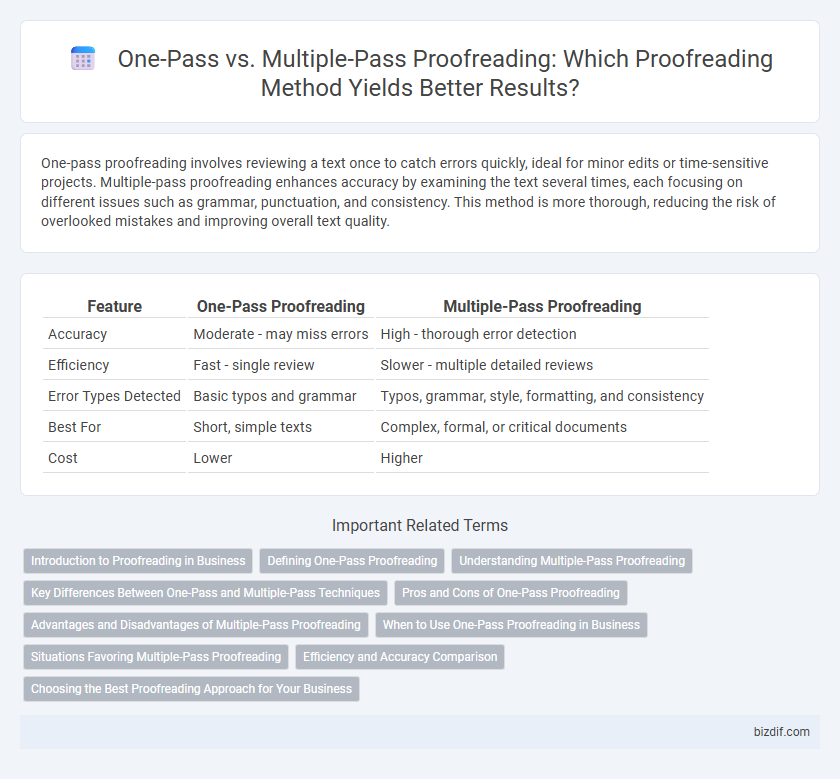One-pass proofreading involves reviewing a text once to catch errors quickly, ideal for minor edits or time-sensitive projects. Multiple-pass proofreading enhances accuracy by examining the text several times, each focusing on different issues such as grammar, punctuation, and consistency. This method is more thorough, reducing the risk of overlooked mistakes and improving overall text quality.
Table of Comparison
| Feature | One-Pass Proofreading | Multiple-Pass Proofreading |
|---|---|---|
| Accuracy | Moderate - may miss errors | High - thorough error detection |
| Efficiency | Fast - single review | Slower - multiple detailed reviews |
| Error Types Detected | Basic typos and grammar | Typos, grammar, style, formatting, and consistency |
| Best For | Short, simple texts | Complex, formal, or critical documents |
| Cost | Lower | Higher |
Introduction to Proofreading in Business
One-pass proofreading offers a quick review to identify obvious errors in business documents, making it suitable for tight deadlines. Multiple-pass proofreading involves several reviews, targeting different error types such as grammar, punctuation, and format consistency, ensuring higher accuracy. Businesses benefit from multiple-pass proofreading by reducing costly mistakes and maintaining professional communication standards.
Defining One-Pass Proofreading
One-pass proofreading involves reviewing a text once to identify and correct errors, focusing on overall accuracy and clarity in a single review. This method prioritizes efficiency and is often used when time constraints are present or when the text is relatively short and straightforward. While one-pass proofreading can catch many surface-level mistakes, it may miss deeper issues that multiple-pass proofreading would address.
Understanding Multiple-Pass Proofreading
Multiple-pass proofreading significantly improves error detection by allowing the proofreader to focus on different types of mistakes in separate readings, such as grammar in one pass and formatting in another. This method reduces the risk of overlooking subtle errors that a single review might miss, enhancing overall text accuracy and quality. Studies indicate that multiple-pass proofreading can increase error identification rates by up to 30% compared to one-pass proofreading.
Key Differences Between One-Pass and Multiple-Pass Techniques
One-pass proofreading involves reviewing a document once, prioritizing speed and spotting obvious errors in grammar, spelling, and punctuation. Multiple-pass proofreading divides the task into several focused readings, each targeting specific error types such as syntax, formatting, and factual accuracy, resulting in higher precision. The key difference lies in efficiency versus thoroughness, with one-pass suited for quick edits and multiple-pass ideal for detailed, error-free finalization.
Pros and Cons of One-Pass Proofreading
One-pass proofreading allows for faster turnaround times and increased efficiency, making it ideal for urgent projects or content with minimal errors. However, it often misses subtle mistakes such as contextual errors, inconsistent formatting, or complex grammatical issues due to the limited review scope. This approach risks lower overall accuracy compared to multiple-pass proofreading, which systematically addresses different error types in separate stages.
Advantages and Disadvantages of Multiple-Pass Proofreading
Multiple-pass proofreading enhances error detection by allowing reviewers to focus on different types of mistakes in each pass, increasing overall accuracy and reducing the likelihood of overlooked errors. However, it is time-consuming and can delay project completion, making it less suitable for tight deadlines or rapid turnaround requirements. The method also demands higher concentration and coordination, potentially increasing labor costs compared to one-pass proofreading.
When to Use One-Pass Proofreading in Business
One-pass proofreading is ideal for time-sensitive business documents that require quick turnaround without compromising essential accuracy, such as emails, memos, or draft reports. It works best when the text has been previously edited for content and structure, allowing the proofreader to focus solely on surface-level errors like typos, grammar, and punctuation. This method saves resources while ensuring professionalism in routine communications and less complex materials.
Situations Favoring Multiple-Pass Proofreading
Multiple-pass proofreading proves essential in complex documents such as academic papers, legal contracts, or technical manuals where detail accuracy and contextual consistency are paramount. This approach allows for dedicated focus on different error types, including grammatical mistakes, formatting issues, and factual inaccuracies. Employing multiple passes reduces the risk of overlooking subtle errors that could undermine document credibility or clarity.
Efficiency and Accuracy Comparison
One-pass proofreading offers greater efficiency by quickly identifying and correcting surface-level errors, making it suitable for tight deadlines and straightforward texts. Multiple-pass proofreading enhances accuracy through successive reviews that target different error types, ensuring comprehensive correction of grammar, punctuation, and style inconsistencies. Balancing efficiency and accuracy depends on project complexity, with multiple-pass methods preferred for high-stakes documents requiring meticulous attention to detail.
Choosing the Best Proofreading Approach for Your Business
One-pass proofreading offers a quick review primarily targeting obvious errors, making it suitable for tight deadlines and simpler documents. Multiple-pass proofreading involves several detailed reviews focusing on different elements like grammar, punctuation, and style, ensuring higher accuracy and professionalism. Selecting the best approach depends on your business's document complexity, quality standards, and time constraints to balance efficiency and precision effectively.
one-pass proofreading vs multiple-pass proofreading Infographic

 bizdif.com
bizdif.com